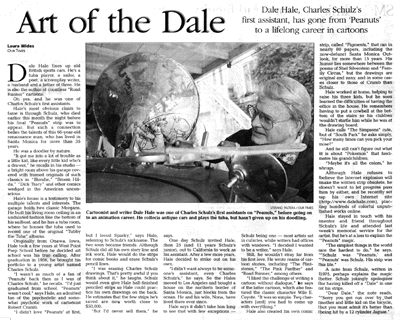 |
Los Angeles Times |
 |
Los Angeles Times |
| Hale's most obvious claim to fame is through Schulz, who died
earlier this month the night before his final "Peanuts" strip was to
appear. But such a connection belies the talents of this 66-year-old renaissance
man, who has lived in the Santa Monica area for more than 37 years. He was a doodler by nature. "It got me into a lot of trouble at school as a little kid, like every little kid who's a drawer," he recalls in his studio--a bright room above his garage covered with the framed originals of such classics as "Blondie," "Broom Hilda," "Dick Tracy" and other comics wedged in the American unconscious. Hale's house is a testimony to his multiple talents and interests. The garage holds two classic Morgans. He built his living room ceiling in an undulated fashion like the bottom of his sailboat, and he has a tuba room, where he houses the tuba used to record one of the original "Tubby the Tuba" albums. Originally from Onawa, Iowa, Hale took a few years at West Point Prep School before he decided art school was his true calling. After graduation in 1956, he brought his portfolio to a young artist named Charles Schulz. "I wasn't as much of a fan of 'Peanuts' back then as I was of Charles Schulz," he recalls. "I'd just graduated from college. "Peanuts' wasn't that cool," says Hale, an admitted fan of the psychedelic and some-what psychotic work of cartoonist Robert Crumb. " I didn't love "Peanuts' at first, but I loved Sparky," says Hale referring to Schulz's nickname. The two soon became friends. Although Schulz did all his own story line and ink work, Hale would do the strips for the comic books and erase Schulz's pencil lines. " I was erasing Charles Schulz original pencil drawings. That's pretty awful if you think about it," he laughs. Schulz would even give Hale half-finished penciled strips so Hale could practice his own drawings on the back. It's estimated that the strips he's saved are now worth well over $50,000. "But I'd never sell them," he says. One day Schulz invited Hale, then 25 (and 11 years Schulz's junior), out to California to work as his assistant. After a few more years, Hale decided to strike out on his own. "I didn't want always to be someone's assistant, even Charles Schulz's," he says. So the Hales moved to Los Angeles and bought a house on the beach in Santa Monica. He and his wife, Nona, have lived there ever since. Hale says it didn't take him long to see that with few exception --- Schulz being one --- most artists sat in cubicles, while writers had offices with windows. "I decided I wanted to be a writer," says Hale, with a smile. Still, he wouldn't stray far from his first love. He wrote reams of cartoons stories, including "The Flintstones," "The Pink Panther" and "Road Runner," among others. "I liked the challenge of writing a cartoon without dialogue," he says of the latter cartoons, which also featured the classic character Wile E. Coyote. "It was so simple. Two characters (and) you had to come up with everything else." Hale also created his own comic strip, called "Figments," that ran world-wide for over 15 years. His humor lies somewhere between the poems of Shel Silverstein and "Family Circus," but the drawings are original and zany, and in some cases closer to those of Crumb than Schulz. Hale worked at home, helping to raise his three kids, but soon learned the difficulties of having his studio there. He remembers having to put a ships bell at the bottom of his studio stairs so his children wouldn't startle him while he was at the drawing board. "They'd just appeared," he said. Hales calls "The Simpsons" cute, but "South Park" he asks simply, "How many times can you pick your nose for a laugh?" And he still can't figure out what it is about "pokemon" that fascinates his grandchildren. "Maybe it's all the colors," he shrugs. Although Hale refuses to believe the Internet explosion will make the written strip obsolete, he doesn't want to let progress pass him by either, and he recently set up his own Internet site, CartoonsForKids.com or DaleHale.com placing hundreds of colorful unpublished works online. He also has a business site at DaleHale'sBestInTown.com. Hale stayed in touch with his mentor and friend throughout Schulz's life and attended his memorial service in Northern California for the artist. But he's at a loss to explain the "Peanuts" magic. "The simplest things in the world are the hardest to do," he says. "Schulz was "Peanuts,' and "Peanuts' was Schulz. His strip was his life." A note from Schulz, written in 1975, perhaps explains the magic better. Schulz jokingly apologizes for having killed off a "Dale" in one of his strips. "Dear Dale," the note reads, "Sorry you got run over by that mother and little kid on the bicycle, but you must admit it's better that being hit by a 12 cylinder Jaguar." ************* |